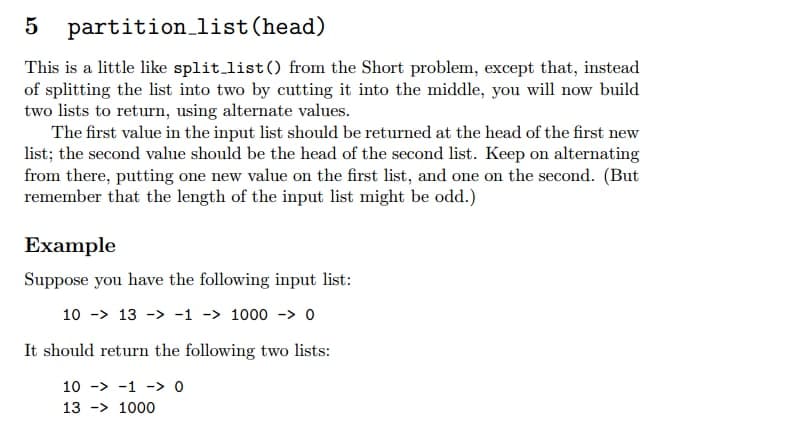5 partition_list (head) This is a little like split_list() from the Short problem, except that, instead of splitting the list into two by cutting it into the middle, you will now build two lists to return, using alternate values. The first value in the input list should be returned at the head of the first new list; the second value should be the head of the second list. Keep on alternating from there, putting one new value on the first list, and one on the second. (But remember that the length of the input list might be odd.) Example Suppose you have the following input list: 10 - 13 -> -1 -> 1000 - 0 It should return the following two lists: 10 > 1 -> 0 13 -> 1000
5 partition_list (head) This is a little like split_list() from the Short problem, except that, instead of splitting the list into two by cutting it into the middle, you will now build two lists to return, using alternate values. The first value in the input list should be returned at the head of the first new list; the second value should be the head of the second list. Keep on alternating from there, putting one new value on the first list, and one on the second. (But remember that the length of the input list might be odd.) Example Suppose you have the following input list: 10 - 13 -> -1 -> 1000 - 0 It should return the following two lists: 10 > 1 -> 0 13 -> 1000
Database System Concepts
7th Edition
ISBN:9780078022159
Author:Abraham Silberschatz Professor, Henry F. Korth, S. Sudarshan
Publisher:Abraham Silberschatz Professor, Henry F. Korth, S. Sudarshan
Chapter1: Introduction
Section: Chapter Questions
Problem 1PE
Related questions
Question

Transcribed Image Text:5 partition_list (head)
This is a little like split_list() from the Short problem, except that, instead
of splitting the list into two by cutting it into the middle, you will now build
two lists to return, using alternate values.
The first value in the input list should be returned at the head of the first new
list; the second value should be the head of the second list. Keep on alternating
from there, putting one new value on the first list, and one on the second. (But
remember that the length of the input list might be odd.)
Example
Suppose you have the following input list:
10 - 13 -> -1 -> 1000 - 0
It should return the following two lists:
10
1
0
13 -> 1000
Expert Solution
This question has been solved!
Explore an expertly crafted, step-by-step solution for a thorough understanding of key concepts.
This is a popular solution!
Trending now
This is a popular solution!
Step by step
Solved in 2 steps

Knowledge Booster
Learn more about
Need a deep-dive on the concept behind this application? Look no further. Learn more about this topic, computer-science and related others by exploring similar questions and additional content below.Recommended textbooks for you

Database System Concepts
Computer Science
ISBN:
9780078022159
Author:
Abraham Silberschatz Professor, Henry F. Korth, S. Sudarshan
Publisher:
McGraw-Hill Education

Starting Out with Python (4th Edition)
Computer Science
ISBN:
9780134444321
Author:
Tony Gaddis
Publisher:
PEARSON

Digital Fundamentals (11th Edition)
Computer Science
ISBN:
9780132737968
Author:
Thomas L. Floyd
Publisher:
PEARSON

Database System Concepts
Computer Science
ISBN:
9780078022159
Author:
Abraham Silberschatz Professor, Henry F. Korth, S. Sudarshan
Publisher:
McGraw-Hill Education

Starting Out with Python (4th Edition)
Computer Science
ISBN:
9780134444321
Author:
Tony Gaddis
Publisher:
PEARSON

Digital Fundamentals (11th Edition)
Computer Science
ISBN:
9780132737968
Author:
Thomas L. Floyd
Publisher:
PEARSON

C How to Program (8th Edition)
Computer Science
ISBN:
9780133976892
Author:
Paul J. Deitel, Harvey Deitel
Publisher:
PEARSON

Database Systems: Design, Implementation, & Manag…
Computer Science
ISBN:
9781337627900
Author:
Carlos Coronel, Steven Morris
Publisher:
Cengage Learning

Programmable Logic Controllers
Computer Science
ISBN:
9780073373843
Author:
Frank D. Petruzella
Publisher:
McGraw-Hill Education